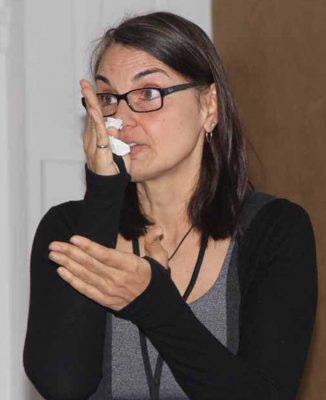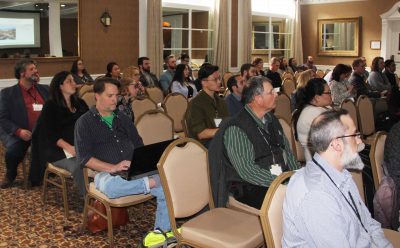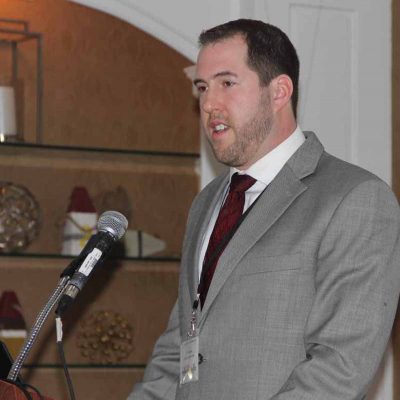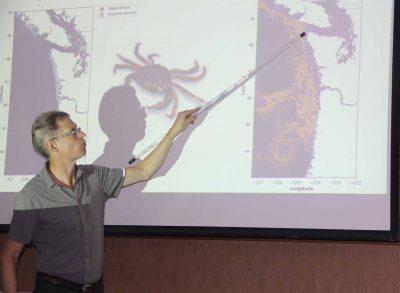
Story and photos by Judy Benson
Figuring out the complex and ever-changing chemistry of Long Island Sound is a bit like making stone soup, the storybook concoction created from an eclectic mix of contributions.
That was the metaphor Penny Vlahos, associate professor of marine sciences at UConn, used to describe her research into quantifying the inputs and reservoirs of nitrogen in Long Island Sound to an audience of fellow researchers, students and environmental scientists on March 15.
Hers was one of three consecutive presentations about different aspects of research into the nutrients and chemistry of the estuary. Sharing related projects focusing on the distributions of carbon and nitrogen and the link between nitrogen sources and water quality in the western Sound were Allison Byrd, a UConn marine sciences graduate student, and Michael Whitney, associate professor of marine sciences.
“Nitrogen is a game changer in Long Island Sound,” said Vlahos, adding that nitrogen from treated wastewater discharges and lawn and agricultural runoff is a major nutrient influencing the health of the estuary. Her project, which involved analysis of water samples from different seasons and locations in the Sound from 1995 to 2016, employed models and data from multiple sources, including the Connecticut Department of Energy and Environmental Protection, the U.S. Geological Survey and the National Atmospheric Deposition Program, which quantifies the amount of airborne nitrogen that falls to Earth. For the Sound, the program calculated that 30 percent of the nitrogen entering the estuary is from the atmosphere, a source that, Vlahos pointed out, is very hard to control.
The purpose of her project, she explained, was to quantify how much nitrogen is entering, leaving and being stored in sediments in the western, central and eastern Sound, so that managers can better respond. Excess nitrogen can cause algal blooms, which in turn leads to hypoxia — oxygen depletion – harmful to many marine plants and animals. The problem occurs most frequently in areas of the western Sound.
“With this biogeochemical budget, we hope to be able to tackle the hypoxia issue and keep it in check,” she said.

The three presentations about Long Island Sound nutrients and chemistry shared the program with more than 25 others focusing on management of tautog for overfishing, habitat restoration projects, the blue crab population, new tools to manage the Sound and numerous other topics at the daylong 2019 Long Island Sound Research Conference. It was sponsored by the Long Island Sound Study, a partnership of federal and state agencies working to restore the estuary, along with Sea Grant programs in Connecticut and New York, and organized by the two Sea Grant programs along with UConn, SUNY Stonybrook and the Long Island Sound Study. The three sponsors were also the source of funding for much of the research presented. Attended by 134 people, the conference took place at Danford’s Hotel and Marina in Port Jefferson, N.Y.
“I continue to be amazed at the diversity and quality of research in Long Island Sound,” said Sylvain De Guise, director of Connecticut Sea Grant, which provided some of the funding for the conference. “A gathering of the minds is good not only to share scientific results and develop the next generation of scientists, but also to stimulate discussions on next steps in the scientific inquiry as well as on how such research can be leveraged to help better manage the Sound.”

Along with many academic researchers, presenters also included Peter Solomon, a teacher at The Sound School in New Haven. He described how students at the magnet high school learned how to construct five concrete reef balls, each about 3 ½ square yards in size, and set them 150 feet offshore from the waterfront school last May. Three of the reef balls, which have openings to allow water and marine life to pass through, were seeded with oysters, while two were set out bare.
“This was a student-directed project,” he said.
After five months in the water, student divers swam to the site to videotape the reef balls in the underwater environment. Solomon played a portion of the video showing the three seeded reef balls covered with oysters and active with blue crabs, fish and other marine life, while the unseeded reef balls remained bare.
“Now,” he said, “we’re looking to expand this project into a living shoreline” – a technique employing oyster reefs and other natural features to restore eroded areas.
Syma Ebbin, research coordinator for Connecticut Sea Grant, noted that the conference included a lively session of more than 20 posters preceded by short talks, and even provided an opportunity for a high school student to present a poster of his work on Project Limulus, which focuses on horseshoe crabs.
“This conference is a great opportunity to showcase new Long Island Sound research and a wonderful opportunity for students ranging from graduate school to high school to present their research,” she said.
The keynote presentation was given by Parker MacCready of the University of Washington’s School of Oceanography. He described the creation of a digital model of the Salish Sea including Puget Sound, an area of commercially valuable fishing and shellfishing, but also low in oxygen and subject to acidification problems that can harm shellfish. These problems are becoming more challenging due to human impacts and increasing atmospheric carbon dioxide.

“We wanted to simulate the real state of the ocean, and make forecasts, and make the model as realistic as possible,” he explained, as images of the model were projected on a screen behind him showing the movement of water currents through the channels and embayments.
The model, he said, is being developed not only for the benefit of researchers and managers, but to be useful to shellfish farmers and the general public.
“We’ve been asked to make the model more relevant to commercial shellfish farmers, with maps showing where and when it’s good or bad to put out oyster seed,” he said. “We’re trying to give the public a different appreciation of the waters that they sail on and live next to. I really hope the public sees this as a portal to see not just environmental problems, but also how the environment works.”
More information about the presentations in the conference can be found in the Abstract Book.
Judy Benson is the communications coordinator at Connecticut Sea Grant.